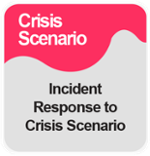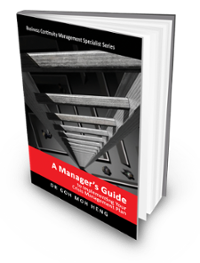 Action Steps for Managing a Death at Work
Action Steps for Managing a Death at Work
Description of Crisis
This section details specific actions to take before, during, and after a death at work.
 This playbook is a training aid for Module 2 Session 2 of the CM-300/ 5000 Implementer/ Expert Implementer Course participants to attempt the CM plan development assignment. This playbook is a training aid for Module 2 Session 2 of the CM-300/ 5000 Implementer/ Expert Implementer Course participants to attempt the CM plan development assignment. |
 |
Scenario: A Staff Died in the Course of Work
Action Steps for Pre-Crisis
Risk Assessment
- Identify Potential Hazards: Conduct a comprehensive workplace hazard assessment to identify potential risks that could lead to severe injuries or fatalities.
- Prioritize Risks: Evaluate the likelihood and severity of each hazard to prioritize risk mitigation efforts.
Emergency Response Plan
- Develop a Comprehensive Plan: Create a detailed emergency response plan outlining procedures for handling various emergencies, including fatalities.
- Define Roles and Responsibilities: Assign specific roles and responsibilities to employees for emergency response, such as first aid, evacuation, and communication.
- Emergency Contact Information: Ensure that emergency contact information for all employees is updated and easily accessible.
Training and Drills
- Safety Training: Conduct regular training sessions to educate employees on workplace hazards, safety protocols, and emergency procedures.
- Emergency Drills: Conduct periodic drills to practice evacuation procedures, first aid, and communication protocols.
- Feedback and Improvement: Evaluate the effectiveness of training and drills and make necessary adjustments to improve preparedness.
Communication Plan
- Internal Communication: Establish clear communication channels within the organization, including procedures for reporting accidents and incidents.
- External Communication: Develop a plan for communicating with external stakeholders, such as the deceased employee's family, media, and regulatory agencies.
Incident Reporting Procedures
- Standardized Forms: Create standardized forms for reporting accidents, incidents, and fatalities.
- Investigation Procedures: Outline procedures for conducting prompt and thorough investigations into incidents.
- Documentation: Ensure that all relevant documentation, such as incident reports, witness statements, and medical records, is adequately maintained.
Employee Assistance Program (EAP)
- Establish an EAP: Implement an EAP to provide support and resources to employees affected by workplace fatalities.
- Crisis Counseling: Ensure EAP counsellors are trained to provide crisis counselling to grieving employees.
- Support Services: Offer other support services, such as grief counselling, legal assistance, and financial counselling.
Legal Matters
- Consult Legal Counsel: Have a legal team ready to guide you on legal obligations and potential liabilities.
- Understand Workplace Accident Laws: Familiarize yourself with relevant workplace accident laws and regulations.
- Prepare for Investigations: Cooperate with government investigations into the incident.
Action Steps for During-Crisis
Immediate Action
- Activate Emergency Services: Call emergency services immediately, providing accurate information about the nature of the incident, the location of the deceased individual, and any necessary medical assistance.
- Ensure Safety: Assess the situation to ensure the safety of other employees and bystanders. If necessary, evacuate the area or take other precautions to prevent further injuries.
- Provide First Aid: If qualified, administer first aid to injured individuals.
Incident Investigation
- Preserve the Scene: Preserve the accident scene to facilitate an investigation.
- Gather Information: Collect information from witnesses, including their names, contact information, and descriptions of what they observed.
- Document the Incident: Take photos or videos of the accident scene to document the circumstances.
Communication
- Notify Stakeholders: Inform relevant stakeholders, such as the deceased employee's next of kin, HR department, and legal counsel, about the incident.
- Follow Communication Plan: Adhere to the established communication plan for internal and external stakeholders.
- Provide Updates: Keep employees and stakeholders informed about the situation and any ongoing investigations.
Employee Support
- Activate EAP: Immediately activate the Employee Assistance Program (EAP) to support grieving employees and their families.
- Offer Counseling: Ensure EAP counsellors can provide crisis counselling to those affected by the tragedy.
- Provide Resources: Offer other support services, such as grief counselling, legal assistance, and financial counselling.
Legal Matters
- Consult Legal Counsel: Consult legal counsel to address legal obligations, such as reporting requirements or potential lawsuits.
- Gather Evidence: Collect and preserve any relevant evidence that may be needed for legal proceedings.
Media Relations
- Prepare for Media Inquiries: Develop a media relations strategy to handle media inquiries and public statements.
- Assign a Spokesperson: Designate a spokesperson to handle media inquiries and ensure consistent messaging.
- Provide Accurate Information: Provide accurate and timely information to the media while respecting the deceased employee's and their family's privacy.
Workplace Safety Review
- Conduct a Thorough Review: Conduct a comprehensive review of workplace safety procedures and practices to identify any contributing factors to the incident.
- Implement Improvements: Implement any necessary improvements to prevent similar incidents in the future.
Action Steps for Post-Crisis
Incident Report
- Prepare a Detailed Report: Create a comprehensive incident report that documents the circumstances of the fatality, including:
- Date and time of the incident
- Location of the incident
- Name of the deceased employee
- Description of the incident and cause of death
- Actions taken during the emergency response
- Relevant documentation (e.g., medical reports, incident photos)
Investigation
- Conduct a Thorough Investigation: Conduct a thorough investigation to identify the root cause of the fatality and determine how it could have been prevented.
- Interview Witnesses: Interview employees involved in the incident and any witnesses to gather additional information.
- Review Safety Procedures: Review existing safety procedures and identify any deficiencies or areas for improvement.
Corrective Actions
- Implement Changes: Implement corrective actions to address the root cause of the fatality and prevent similar incidents from happening in the future.
- Update Safety Procedures: Modify safety procedures to reflect the lessons learned from the investigation.
- Retrain Employees: Provide additional training on updated safety procedures and best practices.
Employee Support
- Continue Support: Continue to provide support to the deceased employee's family, including grief counselling, financial assistance, and any other necessary resources.
- Offer Support to Colleagues: Support employees affected by the tragedy, including counselling and bereavement leave.
Legal Matters
- Address Legal Obligations: If necessary, work with legal counsel to address any legal obligations, such as workers' compensation claims or lawsuits.
- Gather Evidence: Collect and preserve any relevant evidence that may be needed for legal proceedings.
Media Relations
- Continue to Monitor Media: Monitor media coverage and address any misinformation or inaccuracies.
- Maintain Open Communication: Communicate openly with the media, providing updates as needed and respecting the privacy of the deceased employee's family.
Workplace Culture and Safety
- Review Workplace Culture: Assess the overall workplace culture and identify any factors contributing to the fatality.
- Strengthen Safety Measures: Implement additional safety measures to enhance workplace safety and prevent future incidents.
Review and Update
- Review Emergency Response Plan: Review the emergency response plan and make necessary updates based on the lessons learned from the incident.
- Conduct Regular Drills: Continue to conduct regular safety training and emergency drills to maintain preparedness.
Summing Up ...
 This playbook outlines a comprehensive approach to managing workplace fatalities. Before a crisis, organizations should conduct risk assessments, develop a comprehensive emergency response plan, train employees on safety procedures, and establish clear communication channels.
This playbook outlines a comprehensive approach to managing workplace fatalities. Before a crisis, organizations should conduct risk assessments, develop a comprehensive emergency response plan, train employees on safety procedures, and establish clear communication channels.
During a crisis, immediate action is crucial, including activating emergency services, providing first aid, and ensuring the safety of others. Incident investigation, stakeholder communication, and employee support are also essential to the response.
After the crisis, organizations should conduct a thorough investigation, implement corrective actions, provide ongoing support to affected employees, and review and update their emergency response plan. By following these steps, organizations can effectively manage a workplace fatality and minimize its impact on employees and the company.
Click the right icon to view more "Playbook"s.
Do You Want to Continue Your CM Professional Training with Certification Remotely?
Reference Guide
 Goh, M. H. (2016). A Manager’s Guide to Implement Your Crisis Management Plan. Business Continuity Management Specialist Series (1st ed., p. 192). Singapore: GMH Pte Ltd.
Goh, M. H. (2016). A Manager’s Guide to Implement Your Crisis Management Plan. Business Continuity Management Specialist Series (1st ed., p. 192). Singapore: GMH Pte Ltd.
More Information About Crisis Management Blended/ Hybrid Learning Courses
To learn more about the course and schedule, click the buttons below for the CM-300 Crisis Management Implementer [CM-3] and the CM-5000 Crisis Management Expert Implementer [CM-5].





![[BL-3-Catalog] What Specialist Level Blended Learning Courses that are Available?](https://no-cache.hubspot.com/cta/default/3893111/4b22a53c-6e3e-4b9e-8c2a-888423f1d26c.png)
![[BL-5-Catalog] What Expert Level Blended Learning Courses that are Available?](https://no-cache.hubspot.com/cta/default/3893111/fe175db3-7f57-4636-bf09-e9a836aa5478.png)





![[BL-CM] [5] Register](https://no-cache.hubspot.com/cta/default/3893111/82024308-16f4-4491-98be-818a882c6286.png)

![Email to Sales Team [BCM Institute]](https://no-cache.hubspot.com/cta/default/3893111/3c53daeb-2836-4843-b0e0-645baee2ab9e.png)





